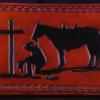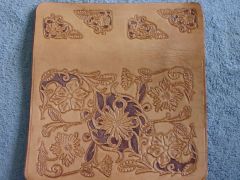-
Posts
14 -
Joined
-
Last visited
About ara
- Birthday 01/25/1947
Profile Information
-
Gender
Male
-
Location
Salida Colorado
-
Interests
Reading, Making stuff, Self-Reliance (reading, classes, DVDs, etc), most anything outdoors except technical climbing and putting slippery sticks under my feet while pointing me downhill on snow. Never made a lick of sense . . .
LW Info
-
Leatherwork Specialty
Waaayyy too early for that
-
Interested in learning about
Utility & Basic Crafting. "Art" will Follow.
ara's Achievements

Member (2/4)
-
-
As the privileged spouse of a veteran letter carrier I have to throw an opinion in here. My bride, who busts her butt and back six days a week with no days off save Sundays and holidays, pretty much agrees although she is used to whiners on both sides of the mailbox. Something that arrives Priority Mail looking pretty good from the outside and loaded with cast iron and styrofoam peanuts on the inside--and being found to be busted all to hell and back when opened--well, the physics don't work on that one, pardner. To sustain multiple fractures in something as stout as cast iron and still have the container it arrived in look "pretty good" just doesn't compute. For that damage to have occurred in transit the first thing to disintegrate would have been the packaging. The first thing. The heavy contents would have torn the packaging from the inside out as multiplied impacts occurred and that apparently didn't happen from what your initial report said. Sounds to me like you paid for a pile of scrap iron and that you were fortunate enough to break even in the end. The stated laxity of the seller in regard to communicating with you raised immediate suspicions on my part. I'd have to bet it was packed that way. Glad to hear all's well. The post office has it's share of crybabies and losers working in its bowels but there are solid gold employees who take their jobs very seriously as well. Remembering that is always appreciated by those who deserve more respect than they are generally afforded. Best in '12. ara
-
Hmm. Actually, I did mean to, yes. Let me look into that.
-
This is actually what I'm considering for the "docking" option. I like the design and, if you read the documentation, it's sort of beggin' for it in my brand spankin' new mind.
-
OK, this is posted here for two reasons: 1) I'm a newbie and Sylvia helped me out more than a time or two already and 2) I wanted to let others know of a source I located for a pounding board that some of you may want to look into as well. In addition, I have a hard time remembering and/or finding where I posted comments so that I can keep some continuity going and that's the case here. Can't recall where the conversation with Sylvia happened so here's a brief rehash: Sylvia suggested I look at granite counter sink cutouts as a source of pounding boards. Here's the IM I sent her to let her know how that worked out. Hi, Syl! May I first wish you a very happy holiday season no matter how you celebrate it. I have appreciated all you've given by way of instruction, suggestion and encouragement. Just thought I'd bring you up to speed on your granite countertop cutout suggestion. I actually took it little further since my small town (pop 7500) hosts distributors and contractors but no fabricators. But we have a lot of old people. So I contacted the mortuary (the mortuary), explained my newfound passion, and asked them who does their headstones. One phone call to another small town two hours south of here got me introduced to a very nice guy who owns and operates a monument company. Being a wise guy at heart I asked if there were remnants or castoffs that might have had a misspelled name or the like. Sadly, he said there were two smaller "unwanted" Veteran's Monuments that were under a few inches of snow in his storage lot. He said he also had a larger piece that the Veteran's Administration actually had misspelled the name on. At first the dimensions he gave me were a little scary but as I thought about it I decided it would be hard to get one too big unless I got ridiculous about it. So I drove through the snow, and had a lovely time doing it, and picked up a beautiful grey granite monument with the gentleman's details on one side and a smooth back. 3'6" long by 13" wide by 4" thick. Clean. Right at 245 pounds. The date on the stone was 1987, so he's had it for a while. He asked $20, I gave him $20, and we were both happy. I don't think a 4" block of granite is going to flex much under a leather punch. =O ) So now I've tasked myself with building a stout, stout rolling table maybe 4' long by 3' wide with a few drawers underneath. Any suggested features for the build? Best to you, Syl. I'm going to copy this to the boards but I wanted you to see it first. Thanks a lot for being there. Bob (ara)
-
Hold that thought--back in a flash. Well, the two places in town are closed--it's Saturday, after all--but I left messages with each. What a great idea! I'll let you know how that works out. ara
-
Zowie, McJeep! A gizmo!! Better, a gizmo and a PLAN!! If I can still find my pocket slide caliper that could be a real deal. Thank you, thank you!
-
Thanks so much for the link, Syl. Most helpful. For what it's worth I've gotten a larger mallet, a couple of stamps (3, actually), some thread (brown & black), needles, a few curved specialty needles, and I'm ordering some stain and edge stain and some other stuff I have in a cart. Also already got a stitch layout embosser set. I need a stamping board and for now my thought is to get a poly cutting board. Please tell me if you think that is a mistake and what your suggestion is either way. For cutting (for now) I will likely just stick with my Stanley razor knife that I used as a contractor and pick up an xacto knife or set. A dial-type hole punch is on the horizon but for now I'm thinking of using my existing Dremel tool with small bits for making stitch holes. Awls in the future possibly but not immediate unless experienced people tell me different. Immediate projects (not started yet but will get appropriate leather bought and start January sometime) are a pocket pouch or two for keys and the ever valuable "stuff" that eats pants Then a hawk sheath out of 8 oz hide, I'm guessing cow, for a Cold Steel Trail Hawk I've had for a while. Very handy tool and there is an excellent 3-part video series on YouTube I'll use. Once that's done the plan is to design and execute a belt loop for the hawk with an integrated pouch for a maintenance and sharpening file for the hawk and other blades I carry in the field. File pouch will likely be 3/4" wide by 6-8" long to receive a single cut file with the tang cut off. One thought is to oil the interior of the file holster 1) to retard water intrusion into the rust-hungry file housing area and 2) to keep a hint of light oil in the immediate proximity of the file itself. The great outdoors is not real friendly toward unprotected tool steel. Note to self: I'll need snaps and an anvil/setting outfit for this. Also need water proofing finish. Oil? Water base acrylic of some sort? I'm really excited to get into this. Again. Syl, thank you. Leatherworker is a great site! ara
-
As a newbie I'm asking things that probably don't even register as first-rung questions but here's a little combination. I'm looking to build a simple project or five as part of my introduction to leatherworking--and I'm starting to see where this just might get to be habit forming. I see consistent references to stock that is 2oz or 6oz or whatever. Is that ounces per square foot or something along those lines? Does the weight (I'm guessing an indicator of thickness) indicate what type of leather it may be (deer, goat, cow, elephant, full or split) or is it just one of several qualifiers that I will eventually learn to fit into the equation of a wise buy? Not complaining, just happily ignorant and working on being thoroughly overwhelmed. Thanks. ara
-
Living leather, at that. Rayban, it's hard to say for sure what the fascination is and an earlier reference to the Iron Cross era is valid. Maybe a lot of it deals with the recognition of inevitability in an aging population and maybe it's simply the technical challenge of doing a skull well. A skull, after all, is an intriguing object. ara
-
TwinOaks: Thanks so much for your swift response. Later in the same evening that I signed on to Leatherworker and this Forum I also groped my way onto YouTube. As I have seen noted elsewhere on these boards there is quite a bit of info for the beginner. "Oaks," as I'll call you in this post, I have an appreciation for good tools. I was a factory-trained Volkswagen mechanic in the early '70s and worked in construction and as a licensed general contractor from 1980 to 1998. So I understand the value of good tools and I also understand that you can scrimp on some few and limited others. Standing with a Snap-On guy with the foreknowledge of what "top end" means is different from shopping ebay or the web and not having any idea of what, for example, "Craftsman" (passable) means as opposed to Snap-On. I took your advice and looked at HideCrafter.com. I believe that will be an invaluable plus to learning what passable to good--even high-end--really is. And thank you for your tip on Tandy. I was looking pretty much through their site and, even to my specialty-ignorant leatherworking eye, their presentation left me wondering if they offered value as well as "stuff." Perhaps they do, but I want to know for sure. For years I have a lot of stuff in my pockets and for years my pockets have been the first thing to go on my pants. So I started thinking and thinking on designing and making a holster of sorts for a stuff-laden keyring. Or perhaps a softer deerskin pouch. Something, at any rate, that would serve as a buffer to save on abrasion damage. That has extended to thoughts of building custom kit holders with "kit" being bush or wilderness kit such as fire kit and water purification kit and all sorts of things. Will they be rigid or somewhat pliable? Don't know yet. Right now, and I don't even know what these things are called so I can research them, I have a couple of ideas for basic tools. One is a sprocket sort of dealy-bob with a handle on it used for laying out stitch lines. Hand in hand would be an awl, perhaps a curved one as well? Awl needles. Cutting tools: maybe quality high-leverage scissors? Hand cutters. I have to think Exacto stuff is not stout enough for the job but I'm certainly open to correction. Punches and tooling items are something I believe I'd like to go higher quality on right out of the gate. Would you agree? Not necessarily top of the line but certainly better than average. And a tooling surface: I've seen what appears to be a lot of granite slab but examples using hard plastic kitchen cutting boards seem to have a certain utility. My thought on that is to get a few cutting, shaping and stitching exercises under my belt (so to speak) before I start in on the tooling aspect of the craft. Much more later, Oaks, but that's it for now I think. On to Sylvia:
-
Hi there! Name's Bob, go by ara, live in Colorado about an inch and a quarter south southwest of center. Have fancied learning leatherworking a time or two and life just kept getting in the way. So here I am, fresh, rosy, and feeling something like a cheerleader in a locker room--not that I'd really know or anything . . . My first post was . . . well . . . somewhere. As I said in that post the extent of my formal training and technical familiarity in working leather centers around tying my own boots for a bit over 60 years. I can comfortably say I've got a hang on that. The rest will come in time. ara
-
My bride and I are starting to hide deer and elk with the intent of doing something . . . somethings . . . a lot of things, actually. I finished an 8" PVC pipe scraping station that I am proud to say doesn't budge even under heavy pressure. So, with that for starting material and probably some storebought when the need or preference arises, I'm looking at the rest of the world of working leather. On the technical side, I can and regularly do lace and tie my own boots. That's the extent of my leather working apprenticeship. I see so much offered in the way of tools and stuff--mostly stuff. Life's lessons have taught me that there is crap and there is quality and often quality is difficult (or temporarily impossible) for a newbie to reasonably judge. That said, can we establish a concensus here on what a newbie ought to look for in the insane number of available gizmos and kits? I really think I can get my head and hands into this, I just don't want to pee away good money on shiny junk. I want to go beyond tying my boots. That doesn't excite my mind anymore. It's my first time. Be gentle. The intro page is my next stop. ara





